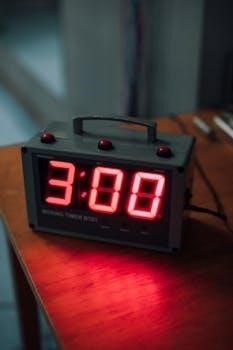Masterplug 7 Day Electronic Timer Instructions⁚ A Comprehensive Guide
Unlock the full potential of your Masterplug 7-Day Electronic Timer! This guide offers clear, concise instructions for optimal energy saving and automated control of your home appliances and security devices. Maximize its 10 programs and 16 options!
Initial Setup and Charging
Before programming your Masterplug 7-Day Electronic Timer, it’s crucial to ensure it’s properly charged. The timer features an internal rechargeable battery that requires an initial charging period. When you first receive the timer, or if it has been unused for an extended period, the display may be dim or blank. This indicates that the battery needs charging.
To begin the initial setup and charging process, follow these steps⁚
- Plug the Timer In⁚ Insert the Masterplug timer into a standard wall socket; Ensure the socket is switched on to allow the timer to receive power.
- Charging Time⁚ Allow the timer to charge for approximately 14 hours. This initial charging period is essential to fully charge the internal battery and ensure reliable operation. During charging, the display may remain dim, but this is normal.
- Avoid Interruption⁚ It’s important to leave the timer plugged in and charging continuously for the entire 14-hour period without interruption. Disconnecting it prematurely may affect the battery’s performance and longevity.
- Battery Indicator⁚ Some models may have a battery indicator on the display. This indicator will typically show that the timer is charging. Once fully charged, the indicator may change or disappear, depending on the specific model.
- Post-Charge Check⁚ After the 14-hour charging period, unplug the timer from the wall socket. The display should now be brighter and clearer, indicating that the battery is sufficiently charged.
- Master Clear (After Charge)⁚ After the initial charge is complete, you should clear all current information. Use a sharp object, like a pen or pencil, to gently press the “MASTER CLEAR” or “RESET” button. This will reset the timer to its factory default settings, preparing it for programming.
Important Considerations⁚
- New Timers⁚ For new timers straight out of the packaging, this initial charging step is particularly important.
- Long Storage⁚ If the timer has been stored for a long time, the battery may have completely discharged. In such cases, the 14-hour charging period is even more critical.
- Consistent Power⁚ Ensure the wall socket you use for charging provides a consistent power supply to avoid any charging interruptions.
- Safety First⁚ Always follow standard electrical safety precautions when plugging in and charging the timer.
By following these initial setup and charging instructions, you’ll ensure that your Masterplug 7-Day Electronic Timer is ready to be programmed and used effectively, providing you with reliable and automated control over your electrical appliances.
Clearing Existing Settings
Before you begin programming your Masterplug 7-Day Electronic Timer with your desired on/off schedules, it’s essential to clear any existing settings that may be stored in the timer’s memory. This ensures that you start with a clean slate and avoid any conflicts or unintended activations based on previous programming. Clearing the existing settings is a simple process that involves using the “MASTER CLEAR” or “RESET” button located on the timer.
Here’s a step-by-step guide on how to clear existing settings on your Masterplug timer⁚
- Locate the “MASTER CLEAR” or “RESET” Button⁚ The “MASTER CLEAR” or “RESET” button is usually a small, recessed button located on the front or side of the timer. It’s often labeled clearly, but if not, consult your timer’s user manual for its exact location.
- Use a Sharp, Non-Conductive Object⁚ Since the button is recessed, you’ll need a small, pointed object to press it. A pen, pencil, or a small screwdriver can be used, BUT ensure the object is non-conductive to prevent any electrical issues. A toothpick or a plastic pen tip is ideal.
- Gently Press and Hold the Button⁚ Carefully insert the sharp object into the recessed button and gently press and hold it for a few seconds (usually 3-5 seconds). You may feel a slight click when the button is pressed.
- Observe the Display⁚ While holding the button, observe the timer’s display. In most cases, the display will either go blank momentarily or reset to its default state, indicating that the memory has been cleared. Some timers might display a confirmation message like “CLEAR” or “RESET” before returning to the default display.
- Release the Button⁚ After observing the display change, release the “MASTER CLEAR” or “RESET” button. The timer should now be free of any previous programming;
- Verify the Clearing⁚ To ensure that the settings have been cleared, you can try navigating through the timer’s menu or programming options. You should find that all the settings have been reset to their default values, as if the timer were brand new.
Important Notes⁚
- Safety First⁚ Always exercise caution when using sharp objects near electrical devices. Ensure the timer is not plugged into a power source during this process to minimize any risk of electric shock.
- Button Sensitivity⁚ Be gentle when pressing the “MASTER CLEAR” button. Applying excessive force could damage the button or the internal circuitry of the timer.
- Consult the Manual⁚ If you are unsure about the location of the “MASTER CLEAR” button or the specific clearing procedure for your timer model, always refer to the user manual for detailed instructions.
- After Clearing⁚ Once you have successfully cleared the existing settings, you are ready to proceed with programming your desired on/off schedules for your appliances and devices.
By following these instructions, you can confidently clear any existing settings on your Masterplug 7-Day Electronic Timer, ensuring a clean and accurate programming experience.
Setting the Current Time and Day

Accurately setting the current time and day on your Masterplug 7-Day Electronic Timer is a crucial first step to ensuring that your programmed on/off schedules function correctly. The timer relies on this information to activate and deactivate your connected appliances and devices at the precise times you intend. An incorrect time or day setting will result in your devices turning on and off at the wrong times, defeating the purpose of automated control. Here’s a detailed guide on how to set the current time and day on your Masterplug timer⁚
- Identify the “CLOCK,” “WEEK,” “HOUR,” and “MIN” Buttons⁚ Locate the buttons responsible for setting the time and day. These are typically labeled as “CLOCK,” “WEEK” (or “DAY”), “HOUR,” and “MIN” on the timer’s control panel. Refer to your user manual if you’re unsure of their specific locations. The “CLOCK” button often acts as an anchor, which needs to be held down while adjusting the other settings.
- Enter Time Setting Mode⁚ Press and HOLD the “CLOCK” button. This activates the time setting mode, allowing you to adjust the day, hour, and minute. Continue holding the “CLOCK” button throughout the next steps until you have set all the values.
- Set the Day of the Week⁚ While holding the “CLOCK” button, press the “WEEK” (or “DAY”) button repeatedly until the correct day of the week is displayed on the screen. The display usually cycles through the days in order (e.g., MON, TUE, WED, etc.).
- Set the Hour⁚ Still holding the “CLOCK” button, press the “HOUR” button repeatedly until the correct hour is displayed. Note whether your timer uses a 12-hour (AM/PM) or 24-hour format and adjust accordingly.
- Set the Minutes⁚ Continue holding the “CLOCK” button and press the “MIN” button repeatedly until the correct minute is displayed.
- Release the “CLOCK” Button⁚ Once you have set the correct day, hour, and minute, release the “CLOCK” button. The timer should now display the current time and day.
- Verify the Settings⁚ Double-check the display to ensure that the time and day are accurate. If you made a mistake, repeat the steps above to correct the settings.
Important Tips and Considerations⁚
- Holding vs. Pressing⁚ Remember to HOLD the “CLOCK” button while adjusting the day, hour, and minute. Releasing it prematurely will exit the time setting mode.
- 12/24 Hour Format⁚ Be mindful of the time format (12-hour or 24-hour) used by your timer. If you accidentally set the wrong AM/PM, the timer will activate your devices at the wrong time of day. Some timers have an option to switch between 12-hour and 24-hour formats in the settings.
- Button Responsiveness⁚ The buttons on the timer may be slightly sensitive. Press them gently and deliberately to avoid accidental multiple presses.
- Power Outages⁚ Some Masterplug timers have a built-in battery backup to retain the time and settings during power outages. However, if the power outage is prolonged, the battery may drain, and you may need to reset the time and day when power is restored.
- Consult the Manual⁚ If you encounter any difficulties or uncertainties, always refer to your timer’s user manual for specific instructions and troubleshooting tips.
By following these instructions carefully, you can ensure that your Masterplug 7-Day Electronic Timer is accurately set to the current time and day, enabling you to effectively automate the control of your home appliances and devices according to your desired schedule.
Programming On/Off Times

The core function of the Masterplug 7-Day Electronic Timer lies in its ability to automate the switching on and off of your electrical appliances according to a pre-determined schedule. This is achieved through programming specific “on” and “off” times for each day of the week, or for combinations of days. Mastering this programming process is essential to maximizing the energy-saving potential and convenience offered by your timer. Here’s a comprehensive guide to programming on/off times⁚

- Locate the “PROG” Button⁚ Identify the “PROG” button on the timer’s control panel. This button initiates the programming mode, allowing you to set the on/off times.
- Enter Programming Mode⁚ Press the “PROG” button once. The display will typically show “1 ON,” indicating that you are about to program the first “on” time.
- Set the “On” Time⁚ Use the “WEEK,” “HOUR,” and “MIN” buttons to set the desired “on” time for the first program.
- “WEEK” Button⁚ Press the “WEEK” button to select the day(s) of the week for which this “on” time should apply. You can choose individual days (e.g., MON, TUE, WED), a group of days (e.g., MON-FRI, SAT-SUN), or the entire week (MON-SUN).
- “HOUR” Button⁚ Press the “HOUR” button to set the hour for the “on” time.
- “MIN” Button⁚ Press the “MIN” button to set the minute for the “on” time.
- Set the “Off” Time⁚ Press the “PROG” button again. The display will now show “1 OFF,” indicating that you are about to program the first “off” time.
- Repeat for “Off” Time⁚ Use the “WEEK,” “HOUR,” and “MIN” buttons to set the desired “off” time for the first program, following the same procedure as for the “on” time. It’s crucial that the days selected for the ‘off’ time match the days selected for the corresponding ‘on’ time.
- Program Additional On/Off Times (If Needed)⁚ If you want to program more than one on/off cycle per day or week, press the “PROG” button again to advance to the next program (e.g., “2 ON,” “2 OFF,” etc.). Repeat steps 3-5 for each additional program. Your Masterplug timer typically has 10 program slots.
- Exit Programming Mode⁚ After you have programmed all your desired on/off times, press the “CLOCK” button to exit the programming mode. The timer will return to displaying the current time and day.
Important Tips and Considerations⁚
- Program Slots⁚ Be aware of the number of program slots available on your timer. Most Masterplug 7-Day Electronic Timers offer 10 program slots, allowing for up to 10 different on/off cycles per week.
- Overlapping Programs⁚ Avoid programming overlapping on/off times, as this can lead to unpredictable behavior. Ensure that each “off” time occurs after its corresponding “on” time.
- Review and Verify⁚ After programming, carefully review all the on/off times to ensure that they are correct. You can cycle through the programs by pressing the “PROG” button.
- Clearing Programs⁚ If you need to clear a program, refer to the section on “Clearing Existing Settings” within the comprehensive guide.
- Daylight Saving Time⁚ Remember to adjust the on/off times accordingly when daylight saving time begins or ends.
- Manual Override⁚ The manual override function (explained in another section) allows you to temporarily override the programmed on/off times if needed.
By carefully following these instructions, you can effectively program your Masterplug 7-Day Electronic Timer to automate the switching on and off of your appliances, saving energy and enhancing the convenience of your home.
Using the Manual Override Feature
The manual override feature on your Masterplug 7-Day Electronic Timer provides you with the flexibility to temporarily bypass the programmed on/off times. This is particularly useful when you need to switch an appliance on or off outside of its scheduled times, without permanently altering your programmed settings. Understanding how to effectively utilize the manual override is crucial for maximizing the timer’s convenience and adaptability. This feature allows you to instantly control the power supply to the connected appliance, regardless of the programmed schedule.
How to Activate and Use the Manual Override⁚
- Locate the “Manual Override” Button⁚ The “Manual Override” button is usually clearly marked on the timer’s control panel, often with symbols like “ON/OFF” or a hand icon. Its exact location may vary slightly depending on the specific model of your Masterplug timer.
- Understand the Override States⁚ The manual override typically toggles between three states⁚
- ON⁚ Forces the appliance to be switched on, regardless of the programmed schedule.
- OFF⁚ Forces the appliance to be switched off, regardless of the programmed schedule.
- AUTO (or Timer Mode)⁚ Returns the timer to its normal programmed operation, following the scheduled on/off times.
- Activating the Override⁚ Press the “Manual Override” button once to change the current state. Each press of the button will cycle through the available states (ON, OFF, AUTO).
- Observe the Indicator⁚ The timer usually has an indicator (e.g., an LED light or a symbol on the LCD display) to show the current override state. Make sure to check the indicator to confirm that you have selected the desired state.
- Returning to Automatic Operation⁚ To return the timer to its normal programmed operation, press the “Manual Override” button until the indicator shows “AUTO” (or a similar indication of timer mode). The timer will then resume following the programmed on/off times.
Scenarios Where Manual Override is Useful⁚
- Unexpected Needs⁚ If you need to use an appliance outside of its programmed times (e.g., using a heater on a warmer-than-expected evening), you can use the manual override to temporarily switch it on.
- Testing⁚ You can use the manual override to test whether an appliance is working correctly, independent of the timer’s schedule.
- Vacations⁚ If you are going on vacation and want to temporarily disable all programmed on/off times, you can use the manual override to switch all connected appliances off.
- Adjusting to Changes⁚ If your daily routine changes temporarily, the manual override allows you to adapt the timer’s operation without reprogramming it.
Important Considerations⁚
- Temporary Effect⁚ Remember that the manual override is temporary. The timer will return to its programmed operation once you set it back to “AUTO” mode.
- Power Outages⁚ In the event of a power outage, the manual override state may be reset. Check the override state after a power outage to ensure it is set as desired.
- Child Safety⁚ If you have young children, be mindful of the location of the manual override button and consider whether they could accidentally change the override state.
- Consult the Manual⁚ Always refer to the specific instructions in your Masterplug timer’s manual for detailed information about the manual override feature.
By understanding and utilizing the manual override feature, you can significantly enhance the flexibility and convenience of your Masterplug 7-Day Electronic Timer, allowing you to adapt its operation to your changing needs without permanently altering your programmed settings.
Troubleshooting Common Issues
Even with careful setup and programming, you might occasionally encounter issues with your Masterplug 7-Day Electronic Timer. This section provides troubleshooting steps for some common problems, helping you quickly resolve them and restore your timer to optimal functionality. Before attempting any troubleshooting, ensure the timer is plugged into a functioning power outlet and that the appliance you’re trying to control is also working correctly.
Timer Not Switching On/Off at Programmed Times⁚
- Check the Program Settings⁚ Double-check that the on/off times are correctly programmed and that the correct day(s) of the week are selected. Ensure that the AM/PM settings are accurate if using a 12-hour clock format.
- Verify the Manual Override⁚ Make sure the timer is not in manual override mode (ON or OFF). The indicator should be set to “AUTO” or timer mode.
- Confirm Power Supply⁚ Ensure that the timer is receiving power. If the display is blank or flickering, the internal battery may need charging (refer to the “Initial Setup and Charging” section).
- Check for Program Conflicts⁚ If you have multiple programs set, ensure that they do not overlap or conflict with each other.
- Reset the Timer⁚ If you’re still experiencing issues, try resetting the timer to its factory default settings (refer to the “Clearing Existing Settings” section).

Display is Blank or Faint⁚
- Charge the Internal Battery⁚ The internal battery may be low or completely discharged. Leave the timer plugged into a power outlet for at least 14 hours to allow the battery to fully charge.
- Check the Power Outlet⁚ Ensure that the power outlet is functioning correctly by plugging in another device.
- Replace the Battery (If Applicable)⁚ Some models have a replaceable battery. Consult the user manual to determine if your timer has a replaceable battery and how to replace it.
Timer Resets Itself or Loses Settings⁚
- Check for Power Fluctuations⁚ Frequent power outages or voltage fluctuations can cause the timer to reset or lose its settings. Consider using a surge protector to protect the timer from power surges.
- Replace the Battery (If Applicable)⁚ A weak or failing internal battery can cause the timer to lose its settings when power is interrupted.
Timer Controls the Wrong Appliance⁚
- Verify Connections⁚ Ensure that the correct appliance is plugged into the timer.
- Check for Multiple Timers⁚ If you have multiple timers in close proximity, ensure that you are programming the correct timer.
Timer is Not Responding to Button Presses⁚
- Reset the Timer⁚ Try resetting the timer to its factory default settings (refer to the “Clearing Existing Settings” section).
- Check for Button Lock (If Applicable)⁚ Some models have a button lock feature to prevent accidental changes. Consult the user manual to determine if your timer has a button lock and how to disable it.
General Tips⁚
- Consult the User Manual⁚ The user manual is your best resource for troubleshooting specific issues with your timer model.
- Contact Customer Support⁚ If you are unable to resolve the issue using these troubleshooting steps, contact Masterplug customer support for assistance.
- Ensure Proper Ventilation⁚ Avoid placing the timer in direct sunlight or in a confined space where it can overheat.
- Keep Away from Moisture⁚ Protect the timer from moisture and humidity, as this can damage the internal components.
By following these troubleshooting steps, you can resolve many common issues and keep your Masterplug 7-Day Electronic Timer functioning properly, ensuring reliable and efficient control of your home appliances.
